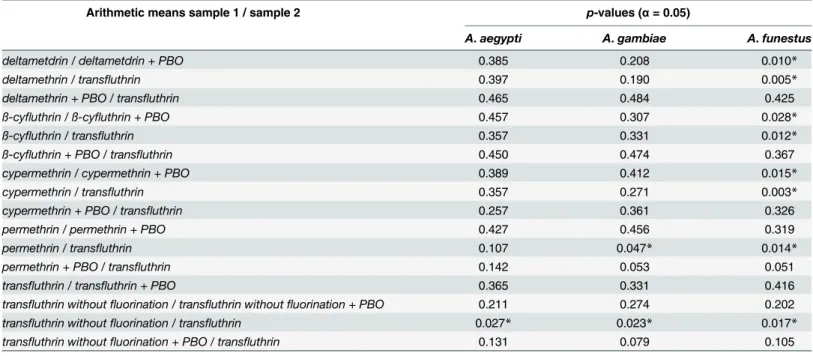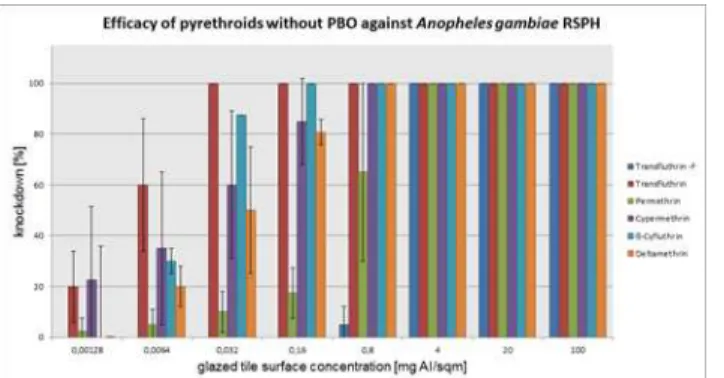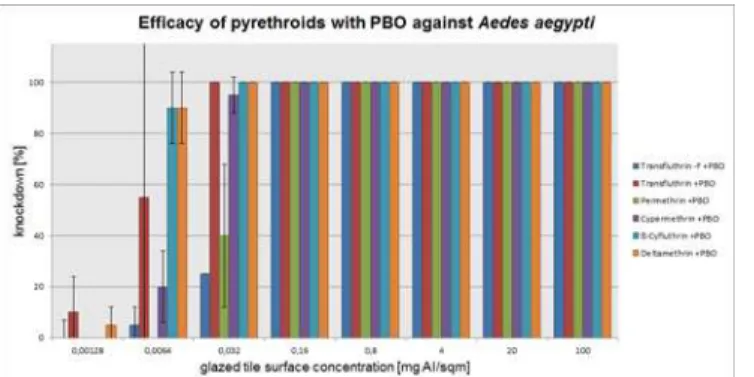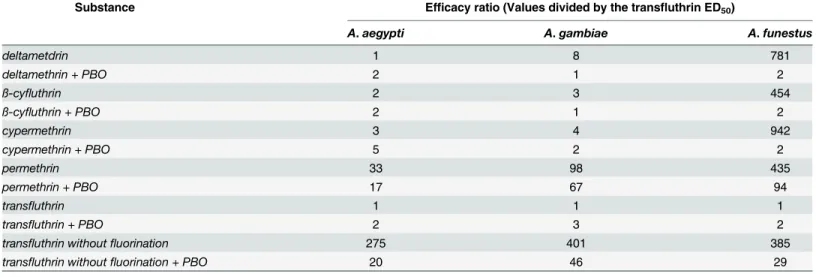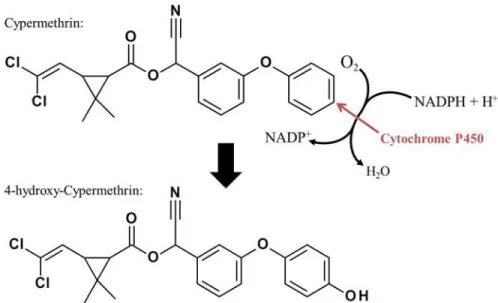Contact Bioassays with Phenoxybenzyl and
Tetrafluorobenzyl Pyrethroids against
Target-Site and Metabolic Resistant Mosquitoes
Sebastian Horstmann*, Rainer Sonneck
Bayer CropScience AG, Monheim am Rhein, Germany
*Sebastian.Horstmann@bayer.com
Abstract
Background
Mosquito strains that exhibit increased tolerance to the chemical class of compounds with a sodium channel modulator mode of action (pyrethroids and pyrethrins) are typically
described as“pyrethroid resistant”. Resistance to pyrethroids is an increasingly important challenge in the control of mosquito-borne diseases, such as malaria or dengue, because one of the main interventions (the distribution of large numbers of long-lasting insecticide-treated bed nets) currently relies entirely on long-lasting pyrethroids. Increasing tolerance of target insects against this class of insecticides lowers their impact in vector control. The cur-rent study suggests that the level of metabolic resistance depends on the structure of the molecule and that structurally different compounds may still be effective because detoxify-ing enzymes are unable to bind to these uncommon structures.
Methods
Treated surface contact bioassays were performed on susceptibleAedes aegypti, East Afri-canknockdown resistance(kdr) Anopheles gambiae(strain RSP-H) and metabolically resistantAnopheles funestus(strain FUMOZ-R) with different pyrethroids, such as cyper-methrin, ß-cyfluthrin, deltacyper-methrin, permethrin and transfluthrin (alone and in combination with the synergist piperonyl butoxide). The nonfluorinated form of transfluthrin was also assessed as a single agent and in combination with piperonyl butoxide.
Results
Although the dosages for pyrethroids containing a phenoxybenzyl moiety have exhibited dif-ferences in terms of effectiveness among the three tested mosquito species, the structurally different transfluthrin with a polyfluorobenzyl moiety remained active in mosquitoes with upregulated P450 levels. In trials with transfluthrin mixed with piperonyl butoxide, the added synergist exhibited no efficacy-enhancing effect.
Conclusion
The results of this study suggest that transfluthrin has the potential to control P450-medi-ated metabolically resistant mosquitoes because the structural formula of transfluthrin OPEN ACCESS
Citation:Horstmann S, Sonneck R (2016) Contact Bioassays with Phenoxybenzyl and Tetrafluorobenzyl Pyrethroids against Target-Site and Metabolic Resistant Mosquitoes. PLoS ONE 11(3): e0149738. doi:10.1371/journal.pone.0149738
Editor:Richard Paul, Institut Pasteur, FRANCE
Received:August 13, 2015
Accepted:February 4, 2016
Published:March 1, 2016
Copyright:© 2016 Horstmann, Sonneck. This is an open access article distributed under the terms of the
Creative Commons Attribution License, which permits unrestricted use, distribution, and reproduction in any medium, provided the original author and source are credited.
Data Availability Statement:All relevant data are within the paper and its Supporting Information files.
Funding:The authors of the present study are employees of Bayer CropScience AG at the time laboratory studies were conducted. Bayer CropScience AG acts as employer and provided support in the form of salaries for the authors [SH and RS], but did not have any additional role in study design, data collection and analysis, decision to publish, or preparation of the manuscript.
differs from that of the tested pyrethroids, which are used in vector control. The P450-detoxi-fying enzymes of theAnopheles funestusFUMOZ-R mosquitoes seem to bind preferably at the phenoxybenzyl moiety and appear to be unable to degrade transfluthrin with its tetra-fluorobenzyl moiety. Inhibition of the class of monooxygenases by piperonyl butoxide revealed no increase of efficacy of the pure transfluthrin compound, which also indicates that the P450 enzymes potentially do not impact the efficacy of transfluthrin.
Background
Pyrethroids are a class of insecticides widely used in agriculture, household insecticides, profes-sional pest control and vector control. In vector control applications, such as indoor residual sprays (IRS) or space sprays, pyrethroids play a major role. For long-lasting insecticidal nets (LLIN), pyrethroids are the only class of insecticides used [1,2]. Most pyrethroids for IRS and LLIN, like cypermethrin or deltamethrin belong to the type II pyrethroids characterized by an
α-cyano sidechain in the molecular structure. Additionally phenoxybenzyl groups are a charac-teristic element of these pyrethroids at the alcohol moiety. Permethrin is a type I pyrethroid, hence it does not contain anα-cyano- but a phenoxybenzyl group and is used for LLIN. The intensive use of pyrethroids and the consequential selection pressure on mosquito populations has led to the establishment of several resistance mechanisms, including physiological alter-ations, such as a thicker cuticle, target-site mutations at the corresponding receptor and increased detoxifying metabolism via specialized enzymes. Pyrethroids act at voltage-gated sodium channels and inhibit the closure of the pore after activation [3]. With target site muta-tions, the receptor to which the compound binds is morphologically altered by the exchange of one or more amino acids. This alteration reduces the binding speed and frequency of the respective compound. The most popular target-site mutation that affects pyrethroids is the so-calledknockdown resistance(kdr) mutation, which occurs due to an amino acid exchange, especially at polypeptide sequence position 1014. Depending on the exchanged amino acid, the kdris referred to as West or East Africankdrdue to its historical geographical distribution. The East Africankdrcarries a serine and the Westkdrcontains a phenylalanine instead of the wild-type amino acid leucine [4,5]. InAedes aegypti, a special type ofkdris described, which is an exchange of a valine to isoleucine at position 1016 and a phenylalanine to cysteine substitution at position 1534 [6].Kdris also observed in several other insects that are targets of the public health sector, such as bed bugs [7], house flies and cockroaches [8]. The presence ofkdrconfers resistance with different resistance ratios, depending on the species in which the sodium chan-nel is tested. For many insects, this ratio is between 5 and 20 for the L1014F mutation [9]. In a molecular model comparing this mutated form of the sodium channel with the wild type, the channel with the target-site resistance has been shown to be 10-fold less sensitive when cisme-thrin was applied and 17-fold less sensitive when deltamecisme-thrin was applied [10]. In this exam-ple a difference in sensitivity between type I and type II pyrethroids is measurable. This finding was supported by tests on genetically modified cockroach sodium channels. Here, depending on the type of target-site mutation a strong tolerance to type I pyrethroids was observed, whereas type II pyrethroids did not show differences to the wild-type channel reaction [11].
Another mechanism responsible for resistance in insects is the metabolic detoxification by specialized enzymes. These proteins are present in living organisms anyway and become a major resistance tool if the corresponding gene coding for such enzyme is duplicated and/or transcription amplification occurs [12]. Resistance takes place if increased amounts of these efficacy of transfluthrin against pyrethroid resistant
enzymes bind to the target molecule and trigger decomposition reactions. One major class of detoxifying enzymes are the P450 monooxygenases, which mainly confer resistance to pyre-throids and carbamates but also to organochlorines and organophosphates. Numerous differ-ent monooxygenases are involved in the detoxifying process depending on the insect species. In the resistantAnopheles funestusstrain FUMOZ-R [13], two copies of the genes CYP6P4 and CYP6P9 are overexpressed 51- and 25-fold compared with the susceptible strainAnopheles funestusAngola (FANG) [14]. The corresponding enzymes play a role in pyrethroid detoxifica-tion. Stevensonet al. [15] identified 4-hydroxydeltamethrin as intermediate in the detoxifica-tion process of deltamethrin by the monooxygenase CYP6M2. This way of metabolizing deltamethrin started at the phenoxybenzyl moiety of the pyrethroid molecule. If the key-lock principle or induced-fit model of CYP6M2 depends on that molecule part, it is suspected that structural different pyrethroids may better withstand metabolism and remain active. 4-hydro-xydeltamethrin was also detected as first degradation product inTribolium castaneum[16]. For a strain of a cotton bollwormHelicoverpa armigerawith upregulated P450 monooxy-genases, Tan and McCaffery showed that structures with polyfluorobenzyl alcohols, lowered the resistance level [17]. The involved enzymes degrade the infiltrated insecticide and reduce or avoid its effect because only small amounts of the enzyme, if any at all, reach the target receptor.Anopheles funestusFUMOZ-R also exhibits morphological resistance due to cuticle thickness, which is increased in the described strain [18]. Lower uptake rates of insecticide might increase the efficacy of metabolic detoxification. This hypothesis is supported by find-ings of Fanget al. 2015, who found 14 cuticle proteins upregulated in deltamethrin-resistant Culex pipiensmosquitoes [19]. In the present study, we tested the efficacy response of a suscep-tibleAedes aegyptilaboratory strain, an East Africankdrresistant strain ofAnopheles gambiae and the P450 resistantAnopheles funestusFUMOZ-R strain to threeα-cyano pyrethroids with phenoxybenzyl moieties, deltamethrin,β-cyfluthrin and cypermethrin and the phenoxybenzyl pyrethroid permethrin that has noα-cyano group. Transfluthrin was selected as a pyrethroid with neither anα-cyano group nor a phenoxybenzyl moiety but with a polyfluorinated benzyl ring. By comparing the polyfluorinated transfluthin with the same chemical structure without fluorination, we generated data about the impact of fluorines on the degradation. The evidence of enhanced oxidative degradation was evaluated by testing mixtures of the pyrethroids and the non-fluorinated transfluthrin with the synergist piperonylbutoxide (PBO).
Materials & Methods
Materials
The technical grade pyrethroids cypermethrin (CAS No. 52315-07-8), permethrin (CAS No. 52645-53-1), ß-cyfluthrin (CAS No. 68359-37-5) and the synergist PBO (CAS No. 51-03-6) were purchased from Sigma-Aldrich1Chemical Company. Technical grade deltamethrin (CAS No. 52918-63-5) and transfluthrin (CAS No. 118712-89-3) were delivered by Bayer CropScience (BCS). The nonfluorinated transfluthrin molecule was synthesized by the Chemi-cal Research department of Bayer CropScience.
Insects
The mosquitoesAnopheles gambiaestrain RSP-H (1),Aedes aegypti(2) andAnopheles funestus strain FUMOZ-R (3) were provided by Bayer CropScience insectary in Monheim, from perma-nent laboratory colonies.
resistance). The strain is described in the reagent catalog of the Malaria Research and Refer-ence Reagent Resource Center (www.MR4.org; MR4-number: MRA-334) as strain RSP (Resistant to permethrin). At MR4, the strain is challenged with permethrin every third gen-eration. The strain was introduced into the authors’rearing laboratories in 2006 without further challenging treatments. Since 2009, this strain has been reared as a 100%kdrstrain, indicating that newly eclosedAnopheles-adults are sorted out of the hatching population and one leg from each adult is analyzed genetically for the presence of thekdrmutation. Afterwards, thekdr-positive mosquitoes are pooled for mating and further rearing. The fre-quency of thekdrmutation in the population is therefore 100%. According to the MR4 web-site, the RSP strain contains elevated P450 enzyme levels, which are therefore also elevated in the RSP-H strain, even if this strain was not reared under permethrin selection pressure.
2. Aedes aegyptiis a susceptible strain that exhibits neither a measurable upregulation of detoxifying enzymes, such as monooxygenases, glutathione-s-transferases or esterases, nor any described target-site mutations (unpublished Bayer CropScience data). The use of an Aedesspecies as a susceptible strain for comparison in this study is based on limited rearing capacities that do not allow the rearing of severalAnophelesspecies. A susceptibleAnopheles strain was therefore not available.
3. Anopheles funestusstrain FUMOZ-R overexpresses P450 monooxygenases, which are involved in the detoxification of pyrethroids. This strain lacks any known target-site muta-tion [12]. The strain was introduced in 2011 into Bayer CropScience rearing department coming from the University of the Witwatersrand, South Africa.
Methods
Bioassay. The mosquitoes with an imago age of 2 to 3 days were anesthetized with carbon dioxide. Ten anesthetized mosquitoes of mixed sex were sorted into a perforated Petri dish, which was subsequently closed by placing a white paper card on top and flipping it over to serve as a small, mobile unit containing 10 mosquitoes. The mosquitoes remained in this mobile unit for at least one hour to minimize the impact of the anaesthetization on the physiol-ogy of the insects. The glazed-tile bioassay is a standard procedure for compound screening in our laboratories and therefore is well established. Further references concerning this testing method can be found in the literature [20,21,22,23,24,25].
Fig 1. The arrangement of the mosquito containing Petri dishes on a glazed tile with an active ingredient-treated surface.
The contact activity was observed during the first 30 min of exposure time. After the expo-sure, the mosquitoes were transferred to an observation table, where they remained for 24 hours. The number of mosquitoes that were knocked down and/or died was recorded after one hour.
In trials with PBO, a stock solution of acetone and 1600 ppm PBO was prepared. This stock solution was used for the 2 mg/ml mixture with the active ingredient. The 1600 ppm also remained constant for dilutions of the active ingredients. Thus, in dilutions of the active ingre-dient, PBO was not diluted in the same manner.
ED50and efficacy ratios. For a side-by-side comparison of the pyrethroid´s activity with
and without PBO on the three mosquito strains we established the ED50in mg/m2(effective
dose to knock down or kill 50%) and the 95% confidence intervals for each substance and strain one hour after contact to the treated surface. The term“effective dose”was used to com-prise knockdown and dead mosquitoes. The relative efficacy of the tested pyrethroids to trans-fluthrin, all with and without PBO, is expressed in form of efficacy ratios. To obtain the efficacy ratio, the calculated ED50of each tested pyrethroid is divided by the transfluthrin ED50
concentration. Transfluthrin represents an efficacy ratio of 1. Factors higher than 1 indicate an increased tolerance of the tested mosquito strain to the tested pyrethroid compared to
transfluthrin.
Fig 2. The close-up view reveals the contact of the test insect with the treated surface of the tile.
All statistical analyses, including control efficacy corrections according to Abbot´s formula and the Probit analysis, were calculated in the software programToxRat1Standard,version 2.10, ToxRat Solutions GmbH, Naheweg 15, D-52477 Alsdorf, Germany, which is a good labo-ratory practice (GLP)-certified statistical program [26].
Results
Table 1shows the effective dose 50% (ED50) in mg/m2and the confidence intervals CI [lower
95%—upper 95%] of all tested active ingredients with and without PBO on three mosquito strains. Thep-values of a one-sided Student´s t-test comparing the measured arithmetic means of selected compound data for significant differences are given inTable 2.
The mean percentage of knockdown after one hour, recorded for each active ingredient con-centration (without PBO) on three mosquito species is presented in Figs3–5. The test results with PBO are shown in Figs6–8. The overall efficacy of the tested active ingredients among the mosquito species revealed differences in the calculated median effective dose (ED50)
concentra-tions and with the addition of PBO, with the exception of transfluthrin.
Table 3gives the calculated efficacy ratios of the pyrethroids and PBO mixtures for each tested mosquito strain. Transfluthrin ED50value was used as divisor of ED50of the respective
pyrethroid.
Aedes aegypti
The pyrethroids tested without PBO were effective against the susceptibleAedes aegypti mos-quito down to the dose rate of 0.0032 mg/m2, with the exception of the nonfluorinated trans-fluthrin. The differences between the compound with PBO and the active ingredient alone are rather low. Deltamethrin was the only pyrethroid that provided 100% control ofAedes aegypti still at a concentration of 0.0064 mg/m2. For the other pyrethroids the dilution step to 0.0064 mg/m2revealed a clear loss of activity. The efficacy at that dose rate did not exceed 65% knock-down. Adding PBO to 0.0064 mg/m2ß-cyfluthrin resulted in an increase to 100% knockdown but a decrease in the efficacy of deltamethrin by 10% and cypermethrin by 40%. PBO appeared to have an effect on 0.032 mg/m2permethrin but especially on the nonfluorinated transfluthrin
Table 1. ED50values with confidence intervals
Substance Aedes aegypti Anopheles gambiae RSP-H Anopheles funestus FUMOZ_R
ED50(mg/m2) CI ED50(mg/m2) CI ED50(mg/m2) CI
deltamethrin 0.0015 [n.d.] 0.0318 [0.0223–0.0451] 14.835 [0.793–2.8119]
deltamethrin + PBO 0.0032 [0.0022–0.0044] 0.0045 [0.0034–0.0059] 0.0031 [0.002–0.0047]
ß-cyfluthrin 0.0042 [0.0027–0.0064] 0.0112 [0.0085–0.0149] 0.8616 [0.194–3.8645]
ß-cyfluthrin + PBO 0.0046 [n.d.] 0.0033 [0.0022–0.0047] 0.0046 [0.0031–0.0070]
cypermethrin 0.006 [n.d] 0.0164 [0.0102–0.0255] 17.906 [0.9049–3.528]
cypermethrin + PBO 0.011 [0.0077–0.0162] 0.009 [0.0065–0.0125] 0.0047 [0.0028–0.0077]
permethrin 0.0691 [0.0439–0.1088] 0.3903 [0.1827–0.8337] 0.8258 [n.d.]
permethrin + PBO 0.0346 [n.d.] 0.2662 [0.1138–0.622] 0.1781 [0.1178–0.2693]
transfluthrin 0.0021 [0.0007–0.0039] 0.004 [0.0029–0.0055] 0.0019 [0.0007–0.0034]
transfluthrin + PBO 0.0049 [0.0031–0.0075] 0.0104 [0.0077–0.0141] 0.0046 [n.d.]
transfluthrin withoutfluorination 0.578 [0.446–1.201] 16.045 [1.199–2.1562] 0.7322 [0.4464–1.2011]
transfluthrin withoutfluorination + PBO 0.0411 [0.027–0.062] 0.1859 [n.d.] 0.0552 [0.0386–0.0812] Table 1: Probit analysis data showing the effective dose 50% (ED50) in mg/m2and the confidence intervals CI [lower 95%—upper 95%].
molecule. Here, 0.16 mg/m2is sufficient for 100% knockdown of the test insects, whereas 4 mg/m2must be used in the absence of PBO. These findings were also reflected in the compari-son of the efficacy ratios forAedes aegypti. To obtain the efficacy ratio, the calculated ED50of
each tested pyrethroid were divided by the concentration of the transfluthrin ED50
concentra-tion. By performing this calculation, an efficacy ratio of 1 represents transfluthrin itself as well as other pyrethroids with a similar effective dose against the same insect species. For example, the following equation was used to calculate the efficacy ratio as shown in a comparison of transfluthrin and the nonfluorinated variant of that molecule inAedes aegypti: (nonfluorinated transfluthrin [0.578] transfluthrin [0.0021] = 0.578/0.0021 = 275). The dosage of the nonfluori-nated transfluthrin that is necessary for 50% knockdown after 1 hour is increased 275-fold compared with transfluthrin. High efficacy ratios indicate therefore a high tolerance of this
Table 2. p-values of a one-sided Student´s t-test comparing the arithmetic means of different samples.
Arithmetic means sample 1 / sample 2 p-values (α= 0.05)
A.aegypti A.gambiae A.funestus
deltametdrin / deltametdrin + PBO 0.385 0.208 0.010*
deltamethrin / transfluthrin 0.397 0.190 0.005*
deltamethrin + PBO / transfluthrin 0.465 0.484 0.425
ß-cyfluthrin / ß-cyfluthrin + PBO 0.457 0.307 0.028*
ß-cyfluthrin / transfluthrin 0.357 0.331 0.012*
ß-cyfluthrin + PBO / transfluthrin 0.450 0.474 0.367
cypermethrin / cypermethrin + PBO 0.389 0.412 0.015*
cypermethrin / transfluthrin 0.357 0.271 0.003*
cypermethrin + PBO / transfluthrin 0.257 0.361 0.326
permethrin / permethrin + PBO 0.427 0.456 0.319
permethrin / transfluthrin 0.107 0.047* 0.014*
permethrin + PBO / transfluthrin 0.142 0.053 0.051
transfluthrin / transfluthrin + PBO 0.365 0.331 0.416
transfluthrin withoutfluorination / transfluthrin withoutfluorination + PBO 0.211 0.274 0.202
transfluthrin withoutfluorination / transfluthrin 0.027* 0.023* 0.017*
transfluthrin withoutfluorination + PBO / transfluthrin 0.131 0.079 0.105
Table 2: Calculatedp-values of a one-sided Student´s t-test (H0= the measured values are randomly different; H1= the measured values are significantly
different;p<0.05 means H1will be accepted–marked with*). doi:10.1371/journal.pone.0149738.t002
Fig 3. Arithmetic means and standard deviations of the 1 h results of a glazed tile contact bioassay using technical grade pyrethroids without PBO against insecticide susceptibleAedes aegypti.
mosquito strain to a certain pyrethroid and if the ratio can be lowered by addition of PBO it indirectly shows the influence of P450 monooxygenases.
In the case ofAedes aegypti, the efficacy ratios are considerably increased for permethrin and the nonfluorinated version of transfluthrin with and without PBO.
Anopheles gambiae
RSP-H
ConcerningAnopheles gambiaeRSP-H only transfluthrin obtained 100% knockdown at 0.032 mg/m2. Deltamethrin, cypermethrin and ß-cyfluthrin knocked down 50%, 60% and 87.5% of Anopheles gambiaeRSP-H. Here, the enhancing effects of PBO were observed with regard to del-tamethrin, cypermethrin and ß-cyfluthrin with 100%, 85% and 97.5% efficacy. PBO exhibited synergistic effects on the nonfluorinated transfluthrin molecule at 0.8 mg/m2. Synergistic effects on permethrin remained low.Anopheles gambiaeRSP-H resisted the treatment of permethrin and the nonfluorinated transfluthrin molecule, with and without PBO. Consequently the efficacy ratios of both substances were increased. While PBO only slightly reduced the ratio of permeth-rin from 98 to 67, the ratio of the nonfluopermeth-rinated transfluthpermeth-rin decreased from 401 to 46.
Anopheles funestus
FUMOZ-R
The greatest differences in tests with and without PBO were observed inAnopheles funestus FUMOZ-R. Deltamethrin, cypermethrin and ß-cyfluthrin containing anα-cyano sidechain
Fig 5. Arithmetic means and standard deviations of the 1 h results of a glazed tile contact bioassay using technical grade pyrethroids without PBO against the metabolic resistantAnopheles funestus FUMOZ-Rstrain.
doi:10.1371/journal.pone.0149738.g005
Fig 4. Arithmetic means and standard deviations of the 1 h results of a glazed tile contact bioassay using technical grade pyrethroids without PBO against thekdr-containingAnopheles gambiae
RSP-H strain.
and a phenoxybenzyl ring in the molecular structure started to lose efficacy below 95% at 20 mg/m2and 4 mg/m2. As PBO was added to these pyrethroids, efficacy was fully recovered at a dosage of 0.032 mg/m2to provide 100% knockdown. The dose rate of permethrin and the nonfluorinated transfluthrin was 0.8 mg/m2. PBO helped at that dose rate to increase efficacy to 100%. While PBO synergized the nonfluorinated transfluthrin at the dose rate of 0.16 mg/ m2to obtain 95% knockdown, the synergistic effect to permethrin was insufficient. In the case of transfluthrin the active ingredient concentrations for 100% knockdown with and without PBO were 0.032 mg/m2. A dose rate of 0.0064 mg/m2resulted in 70% efficacy and was increased up to 90% by adding PBO. Efficacy below 50% was recorded at the lowest tested dose rate of 0.00128 mg/m2with transfluthrin. The addition of PBO to that dose rate resulted in a complete loss of efficacy. The efficacy data onAnopheles funestusFUMOZ-R mosquitoes revealed increased efficacy ratios between the lowest (nonfluorinated transflu-thrin) to the highest 942 (cypermetransflu-thrin) for the straight pyrethroids. However, PBO showed a severe impact on the efficacy of the type II pyrethroids deltamethrin, cypermethrin and ß-Cyfluthrin. If PBO was added to these pyrethroids, the metabolic degradation was suppressed to an efficacy ratio of 2. The ratios of PBO to permethrin and the nonfluorinated transflu-thrin were less dominant.
Fig 6. Arithmetic means and standard deviations of the 1 h results of a glazed tile contact bioassay using technical grade pyrethroids with PBO (1600ppm) against insecticide susceptibleAedes aegypti.
doi:10.1371/journal.pone.0149738.g006
Fig 7. Arithmetic means and standard deviations of the 1 h results of a glazed tile contact bioassay using technical grade pyrethroids with PBO (1600 ppm) against thekdr-containingAnopheles gambiaeRSP-H strain.
Discussion
As expected, when applied to the susceptibleAedes aegyptistrain, low concentrations of all pyrethroid molecules achieved 50% knockdown (Table 1). Comparing the ED50values of the
Aedescolumn, permethrin and nonfluorinated transfluthrin required relatively higher dosages (Table 1). The combination with PBO resulted in lower ED50concentrations only for these two
molecules, which may indicate an involvement of baseline P450. The same applies to the Anopheles gambiaeRSP-H strain. Since, with the exception of transfluthrin, all ED50values of
the tested pyrethroids are reduced by adding PBO, it is rather likely that specialized P450 enzymes are upregulated in this mosquito strain on top of the target-site resistance (Table 1). This assumption is supported by the calculated efficacy ratios that exhibit higher values for the straight compounds. The addition of PBO lowered the efficacy ratios, in the case of deltame-thrin and ß-cyfludeltame-thrin to the transfludeltame-thrin level. A notable influence of the target-site resistance could not be measured and a comparison between the tested mosquito strains would be impre-cise as the insects belong to different genera.
Resistance factors conferred by thekdrmutation are described as uniform at approximate values of 14 [27] or 20 to 50 [28]. Higher resistance factors have been observed between suscep-tible and metabolically resistant mosquito strains,e.g., a 2500-fold increased resistance to per-methrin compared with a susceptible strain inCulex quinquefasciatus[29].
However, given that the two mechanisms included in this trial can act independently, a combination of target-site and metabolic resistance would represent a major hurdle for effec-tiveness of an insecticide. To overcome strong resistance to pyrethroids, active ingredients with different modes of action or mixtures of active compounds with synergists, such as PBO, are used, and their use has been the main strategy to date. TheAnopheles funestusstrain
FUMOZ-R is described as highly pyrethroid resistant [13,30] and the measured ED50values in
this study confirmed this (Table 1).
High efficacy ratios were noted with all tested pyrethroids in the FUMOZ-R strain
(Table 3). Clearly, these pyrethroids can be more easily detoxified than transfluthrin. The resis-tance can be overcome by using PBO, which again suggests the involvement of P450 enzymes. In this case the ratios for deltamethrin, ß-cyfluthrin and cypermethrin were brought down to the transfluthrin level (Table 3). These results were supported by the test for significance that revealed differences in comparison of the single pyrethroids with their synergized variant or with transfluthrin (Table 2). Differences in the comparison of the synergized pyrethroid with transfluthrin are caused by randomness except for the data of permethrin and nonfluorinated transfluthrin. These two active ingredients are of lower toxicity than transfluthrin itself.
Fig 8. Arithmetic means and standard deviations of the 1 h results of a glazed tile contact bioassay using technical grade pyrethroids with PBO (1600 ppm) against the metabolic resistantAnopheles funestus FUMOZ-Rstrain.
If PBO does not synergize transfluthrin, as our study indicates, the P450 monooxygenases potentially are not involved in the detoxification processes of this molecule (Tables1and3). The addition of PBO slightly increased the efficacy ratio but this effect is not significant (Table 2). The reason for the inability of metabolic degradation of transfluthrin inAnopheles funestusFUMOZ-R could be the molecular structure, which is unlike other common throids: the alcoholic sidechain contains a tetrafluorobenzyl ring, whereas most common pyre-throids show a phenoxybenzyl ring. An intermediate in the detoxification process of
deltamethrin is 4-hydroxydeltamethrin [15,16] and a similar path of detoxification was con-firmed for permethrin [31]. According to these findings, the metabolism of deltamethrin and permethrin starts at the phenoxybenzyl moiety of the molecule involving P450 enzymes. The monooxygenase CYP6D1 was found to be part of deltamethrin degradation in houseflies and it was further described that this detoxification occurred at a single site at the phenoxybenzyl moiety [32]. The same effect was observed with cypermethrin when 4-hydroxycypermethrin was identified as a metabolite by gas chromatography/mass spectrometry [32]. A schematic representation about this first step in an enzyme triggered decomposition cascade with the aim to detoxify and excrete cypermethrin is shown below (Fig 9).
In trials withCulex quinquefasciatusstrains from Saudi Arabia with upregulated P450, high levels of resistance were described for pyrethroids with phenoxybenzyl moieties [33]. Interest-ingly, this type of detoxification is not restricted to one class of insecticides. The mechanism also works for the class of juvenile hormone mimics, where monooxygenases are involved in the degradation of pyriproxyfen in white flies [34] and microsomal extracts of houseflies [35]. The main metabolites here were 4- and 5-hydroxypyriproxyfen, suggesting once again a detox-ification that starts at the phenoxybenzyl moiety of this compound.
Data presented in this study show transfluthrin as highly effective pyrethroid against Anopheles funestusFUMOZ-R. The activity indicates the inability of monooxygenases to detoxify this structurally different pyrethroid that lacks a phenoxybenzyl moiety. The addition of PBO did not increase the activity, which supports the hypothesis that P450 enzymes are not involved in the detoxification processes of transfluthrin. To test whether this is based on the fluorination of the benzoyl ring of transfluthrin, a molecule with a similar structure but without fluorination was constructed. The efficacy of this nonfluorinated transfluthrin-like molecule
Table 3. Calculated efficacy ratios.
Substance Efficacy ratio (Values divided by the transfluthrin ED50)
A.aegypti A.gambiae A.funestus
deltametdrin 1 8 781
deltamethrin + PBO 2 1 2
ß-cyfluthrin 2 3 454
ß-cyfluthrin + PBO 2 1 2
cypermethrin 3 4 942
cypermethrin + PBO 5 2 2
permethrin 33 98 435
permethrin + PBO 17 67 94
transfluthrin 1 1 1
transfluthrin + PBO 2 3 2
transfluthrin withoutfluorination 275 401 385
transfluthrin withoutfluorination + PBO 20 46 29
was reduced in all tested mosquito strains, indicating that the P450 enzymes were now able to detoxify the molecule to a greater extent. The combination of PBO with nonfluorinated trans-fluthrin restored the efficacy and therefore lowered the ED50values and efficacy ratios (Tables 1and3). A hypothetic hydroxylation scheme for the nonfluorinated transfluthrin can be found inS1 Fig. The tetrafluoro substituents on the benzyl ring of transfluthrin appear to act as a shield, protecting it from the degradation process (Fig 10). Transfluthrin exhibits a favorable toxicological profile in mammals, indicating effective detoxification or degradation mecha-nisms. Current findings [36] suggest that in mammals, the first metabolites are created by an esterase activity that cleaves transfluthrin into the corresponding acid and alcohol molecules (e.g., 2,3,5,6-tetrafluorobezyl alcohol and 3-(2,2-dichlorovinyl)-2,2-dimethylcyclopropane car-boxylic acid (DCCA)). These molecules as well as further hydrolyzed metabolites are water sol-uble and can be rapidly eliminated via the urinary system [36]. If these esterases were identified in mosquitoes, they would probably also be able to degrade transfluthrin in the same manner as other common pyrethroids because the esterase cleavage site is present in almost all pyre-throids, except etofenprox. Another resistance mechanism in the testedAnopheles funestus FUMOZ-R strain has been described as a thicker cuticle on the legs and tarsi, which represents a greater barrier for the insecticide to enter the insect body [18]. One hypothesis is that the high volatility of transfluthrin allows the compound to enter the insect via the respiratory sys-tem where it could therefore bypass this resistance mechanism.
Fig 9. In pyrethroids with a phenoxybenzyl moiety, P450 enzymes catalyze the hydroxylation from,e.
g., cypermethrin to 4-hydroxy-cypermethrin.The hydroxylation reaction occurs under usage of oxygen and the cofactor NADPH.
doi:10.1371/journal.pone.0149738.g009
Fig 10. P450 enzymes are potentially unable to use transfluthrin with a polyfluorobenzyl ring as suitable substrate for the P450-mediated way of detoxification.
The results of these experiments illustrate that transfluthrin was unaffected by the pyre-throid detoxification enzymes from the class of monooxygenases found inAnopheles funestus FUMOZ-R andAnopheles gambiaeRSP-H. This finding is possibly attributable to its different structural formula compared with the other pyrethroids tested (most of which are commonly used in vector control). Further investigation is needed to support this hypothesis and confirm the potential for transfluthrin to be effective against metabolically resistant mosquitoes in field trials. Given that several published studies have already suggested that P450-mediated detoxifi-cation is very common in insects (and notably, inAnophelesmalaria vectors), transfluthrin could become an important resistance management tool to help overcome this type of meta-bolic resistance.
Supporting Information
S1 Fig. Hypothetical hydroxylation scheme for the nonfluorinated transfluthrin molecule.
(TIF)
S1 Table. Knockdown/mortality results of the glazed tile contact bioassay using technical grade type II pyrethroids (surface concentration shown in the respective row) with and without the addition of piperonyl butoxide (1600 ppm) against three different mosquito strains.
(PDF)
S2 Table. Knockdown/mortality results of the glazed tile contact bioassay using technical grade type I pyrethroids (surface concentration shown in the respective row) with and with-out the addition of piperonyl butoxide (1600 ppm) against three different mosquito strains.
(PDF)
Acknowledgments
Special thanks go to Justin Fraser McBeath, who made many comments and corrections. We also thank Rolf Jung, Katja Falke and Nina Dahlhoff for the performance of the planned trials and the acquisition of the test results. For the rearing and supply of the test insects, we thank Joerg Egger and Melanie Nolden. We are grateful for the support and scientific advice of Ralf Nauen.
Author Contributions
Conceived and designed the experiments: SH RS. Performed the experiments: SH. Analyzed the data: SH. Contributed reagents/materials/analysis tools: SH RS. Wrote the paper: SH RS.
References
1. Van den Berg H, Zaim M, Yadav RS, Soares A, Ameneshewa B, Mnzava A, et al. Global trends in the use of insecticides to control Vector-borne diseases. Environ Health Perspect. 2012; 120: 577–582 [ doi:10.1289/ehp.1104340] PMID:22251458
2. Liu N, Xu Q, Zhu F, Zhang L. Pyrethroid resistance in mosquitoes. Insect Sci. 2006; 13: 159–166 [ doi:
10.1111/j.1744-7917.2006.00078.x]
3. Wakeling EN, Neal AP, Atchison WD. Pyrethroids and their effects on Ion Channels. INTECH Open Access Publisher; 2012.
5. Martinez-Torres D, Chandre F, Williamson MS, Darriet F, Bergé JB, Devonshire AL, et al. Molecular characterization of pyrethroidknockdown resistance (kdr)in the major malaria vectorAnopheles gam-biaes.s. Insect Mol Biol. 1998; 7: 179–184 [ doi:10.1046/j.1365-2583.1998.72062.x] PMID:9535162
6. Harris AF, Rajatileka S, Ranson H. Pyrethroid resistance inAedes aegyptifrom Grand Cayman. Am J Trop Med Hyg. 2010; 83: 277–284 [ doi:10.4269/ajtmh.2010.09–0623] PMID:20682868
7. Zhu F, Wigginton J, Romero A, Moore A, Ferguson K, Palli R, et al. Widespread distribution of knock-down resistance mutations in the Bed BugCimex lectularius(Hemiptera: Cimicidae), populations in the United States. Arch Ins Biochem Phys. 2010; 73: 1–13.
8. Xu Q, Wang H, Zhang L, Liu N. Sodium channel gene expression associated with pyrethroid resistant house flies and German cockroaches. Gene. 2006; 379: 62–67 [ doi:10.1016/j.gene.2006.04.013] PMID:16828989
9. Soderlund DM. Pyrethroids, knockdown resistance and sodium channels. Pest Manag Sci. 2008; 64: 610–616 [ doi:10.1002/ps.1574] PMID:18383430
10. Soderlund DM, Knipple DC. The molecular biology of knockdown resistance to pyrethroid insecticides. Insect Biochem Mol Biol. 2003; 33: 563–577 [ doi:10.1016/S0965-1748(03)00023-7] PMID:12770575
11. Hu Z, Du Y, Nomura Y, Dong K. A sodium channel mutation identified inAedes aegyptiselectively reduces cockroach sodium channel sensitivity to type I, but not type II pyrethroids. Insect Biochem Mol Biol. 2011; 41: 9–13 doi:10.1016/j.ibmb.2010.09.005PMID:20869441
12. Perry T, Batterham P, Daborn PJ. The biology of insecticidal activity and resistance. Insect Biochem Mol Biol. 2011; 41: 411–422 [ doi:10.1016/j.ibmb.2011.03.003] PMID:21426939
13. Hunt RH, Brooke BD, Pillay C, Koekemoer LL, Coetzee M. Laboratory selection for and characteristics of pyrethroid resistance in the malaria vectorAnopheles funestus. Med Vet Entomol. 2005; 19: 271– 275 [ doi:10.1111/j.1365-2915.2005.00574.x] PMID:16134975
14. Bass C, Field LM. Gene amplification and insecticide resistance. Pest Manag Sci. 2011; 67: 886–890 [ doi:10.1002/ps.2189] PMID:21538802
15. Stevenson BJ, Bibby J, Pignatelli P, Muangnoicharoen S, O’Neill PM, Lian LY, et al. Cytochrome P450 6M2 from the malaria vectorAnopheles gambiaemetabolizes pyrethroids: sequential metabolism of deltamethrin revealed. Insect Biochem Mol Biol. 2011; 41: 492–502 [ doi:10.1016/j.ibmb.2011.02.003] PMID:21324359
16. Zhu F, Parthasarathy R, Bai H, Woithe K, Kaussmann M, Nauen R, et al. A brain-specific cytochrome P450 responsible for the majority of deltamethrin resistance in the QTC279 strain ofTribolium casta-neum. Proc Natl Acad Sci U S A. 2010; 107: 8557–8562 [ doi:10.1073/pnas.1000059107] PMID:
20410462
17. Tan J, McCaffery AR. Efficacy of various pyrethroid structures against a highly metabolically resistant isogenic strain ofHelicoverpa armigera(Lepidoptera: Noctuidae) from China. Pest Manag Sci. 2007; 63: 960–968 [ doi:10.1002/ps.1419] PMID:17685437
18. Wood O, Hanrahan S, Coetzee M, Koekemoer L, Brooke B. Cuticle thickening associated with pyre-throid resistance in the major malaria vectorAnopheles funestus. Parasites Vectors. 2010; 3: 67 [ doi:
10.1186/1756-3305-3-67] PMID:20684757
19. Fang F, Wang W, Zhang D, Lv Y, Zhou D, Ma L, et al. The cuticle proteins: a putative role for deltame-thrin resistance inCulex pipiens pallens. Parasitol Res. 2015; 114: 4421–4429 [ doi: 10.1007/s00436-015-4683-9] PMID:26337265
20. Toews MD, Subramanyam B, Rowan JM. Knockdown and mortality of adults of eight species of stored-product beetles exposed to four surfaces treated with spinosad. J Econ Entomol. 2003; 96: 1967–1973. [ doi:10.1093/jee/96.6.1967] PMID:14977140
21. Bong LJ, Neoh KB, Jaal Z, Lee CY. Contact toxicity and residual effects of selected insecticides against the adultPaederus fuscipes(Coleoptera: Staphylinidae), J Econ Entomol. 2013; 106: 2530–2540. PMID:24498755
22. Jones SC, Bryant JL. Contact toxicity and residual efficacy of Indoxacarb against the European earwig (Dermaptera: Forficulidae). Insects. 2012; 3: 593–600 [ doi:10.3390/insects3030593] PMID:26466616
23. Barile J, Nauen R, Nentwig G, Pospischil R, Reid B. Laboratory and field evaluation of Deltamethrin and Bendiocarb to controlCimex lectularius(Heteroptera: Cimicidae). Proceedings of the 6th Interna-tional Conference on Urban Pests; 2008.
24. Wege PJ, Hoppé MA, Bywater AF, Weeks SD, Gallo TS. A microencapsulated formulation of lambda-cyhalothrin. Proc. 3rd Int. Conf. Urban Pests, 1999.
25. How YF, Lee CY. Surface contact toxicity and synergism of several insecticides against different stages of the tropical bed bug,Cimex hemipterus(Hemiptera: Cimicidae). Pest Manag Sci. 2011; 67: 734–740 [ doi:10.1002/ps.2123] PMID:21370390
27. Davies TG, Field LM, Usherwood PN, Williamson MS. DDT, pyrethrins, pyrethroids and insect sodium channels. IUBMB Life. 2007; 59: 151–162 [ doi:10.1080/15216540701352042] PMID:17487686
28. Bhupinder PSK. Pyrethroid insecticides. Royal Soc Chem. 2002; 4: 49–54.
29. Amin AM, Hemingway J. Preliminary investigation of the mechanisms of DDT and pyrethroid resistance inCulex quinquefasciatusSay (Diptera: Culicidae) from Saudi Arabia. Bull Entomol Res. 1989; 79: 361–366 [ doi:10.1017/S0007485300018356]
30. Hargreaves K, Koekemoer LL, Brooke BD, Hunt RH, Mthembu J, Coetzee M.Anopheles funestus
resistant to pyrethroid insecticides in South Africa. Med Vet Entomol. 2000; 14: 181–189 [ doi:10.1046/ j.1365-2915.2000.00234.x] PMID:10872862
31. Kasai S, Komagata O, Itokawa K, Shono T, Ng LC, Kobayashi M, et al. Mechanisms of pyrethroid resis-tance in the dengue mosquito vector,Aedes aegypti: target site insensitivity, penetration, and metabo-lism. PLOS Neglected Trop Dis. 2014; 8: e2948 [ doi:10.1371/journal.pntd.0002948]
32. Scott JG, Wen Z. Cytochromes P450 of insects: the tip of the iceberg. Pest Manag Sci. 2001; 57: 958– 967 [ doi:10.1002/ps.354] PMID:11695190
33. Weerasinghe IS, Kasai S, Shono T. Correlation of pyrethroid structure and resistance Level inCulex quinquefasciatussay from Saudi Arabia. J Pestic Sci. 2001; 26: 158–161 [ doi:10.1584/jpestics.26. 158]
34. Ma W, Li X, Dennehy TJ, Lei C, Wang M, Degain BA, et al. 2010 Pyriproxyfen resistance ofBemisia tabaci(Homoptera: Aleyrodidae) biotype B: metabolic mechanism. J Econ Entomol. 2010; 103: 158– 165. [ doi:10.1603/EC09122] PMID:20214381
35. Zhang L, Kasai S, Shono T. In vitro metabolism of pyriproxyfen by microsomes from susceptible and resistant housefly larvae. Arch Insect Biochem Physiol. 1998; 37: 215–224. PMID:9465388
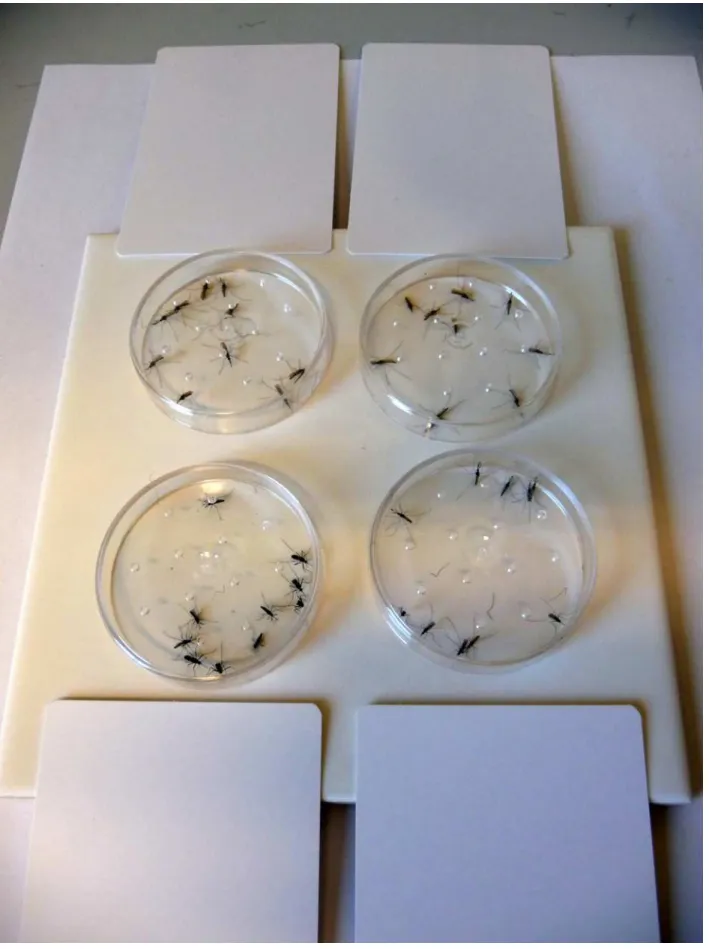

![Table 1 shows the effective dose 50% (ED 50 ) in mg/m 2 and the confidence intervals CI [lower 95%—upper 95%] of all tested active ingredients with and without PBO on three mosquito strains](https://thumb-eu.123doks.com/thumbv2/123dok_br/17255032.245960/7.918.54.865.132.413/effective-confidence-intervals-tested-active-ingredients-mosquito-strains.webp)
